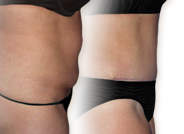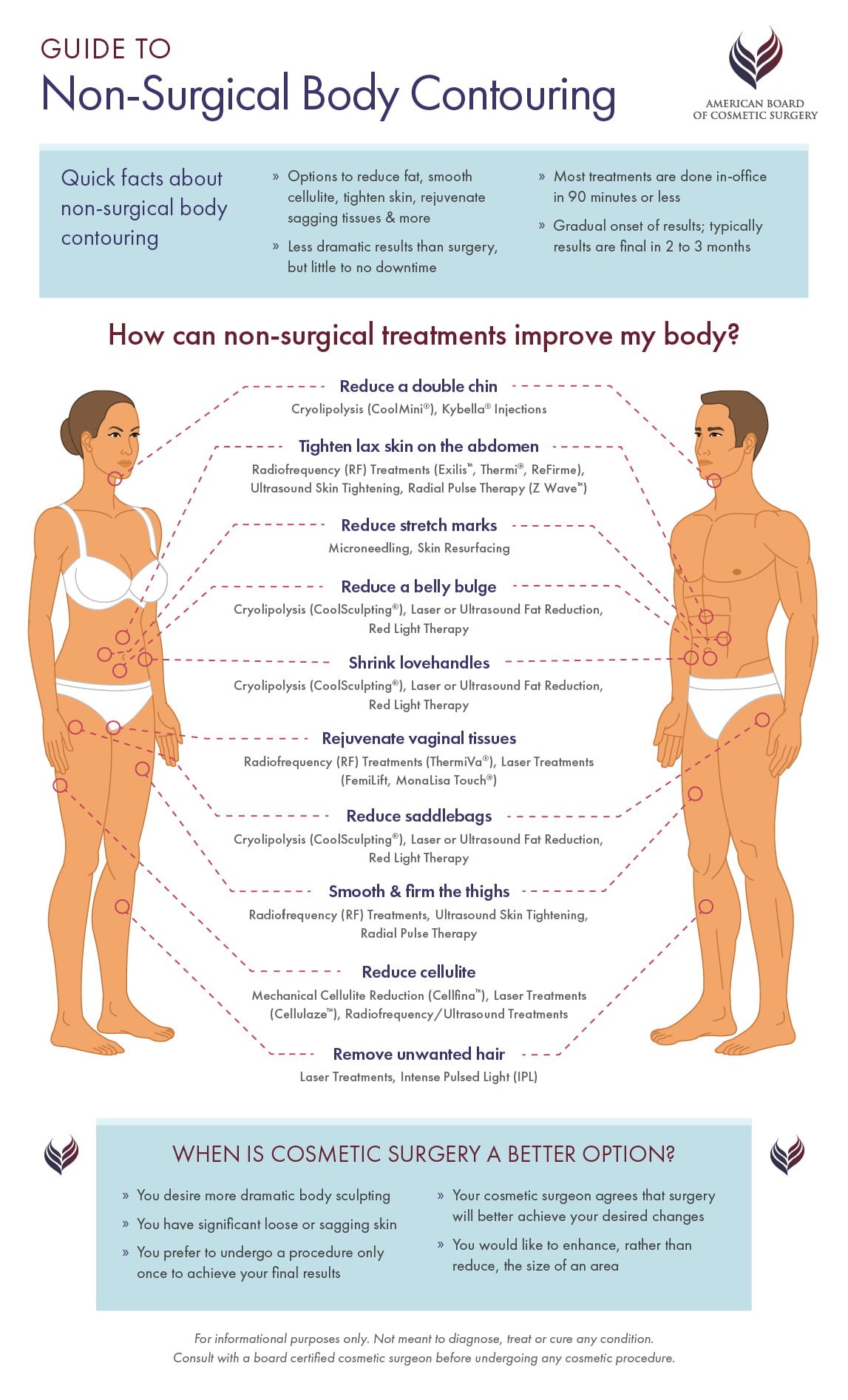Guide to Non-Surgical Skin Tightening
In general, non-surgical skin tightening procedures work by using targeted energy to heat deeper layers of skin, which stimulates collagen and elastin production and gradually improves skin tone and texture. Some treatments also affect fibrous tissue to help smooth cellulite. There are numerous FDA cleared skin tightening treatments and technologies on the market, and each uses a unique mechanism to achieve the desired result. This guide will help you learn more about non-surgical skin tightening and your various options.
- Why consider non-surgical skin tightening?
- Am I a good candidate?
- Non-surgical skin tightening treatments & technologies
- Infographic guide to non-surgical body contouring options
- Choosing a non-surgical skin tightening provider
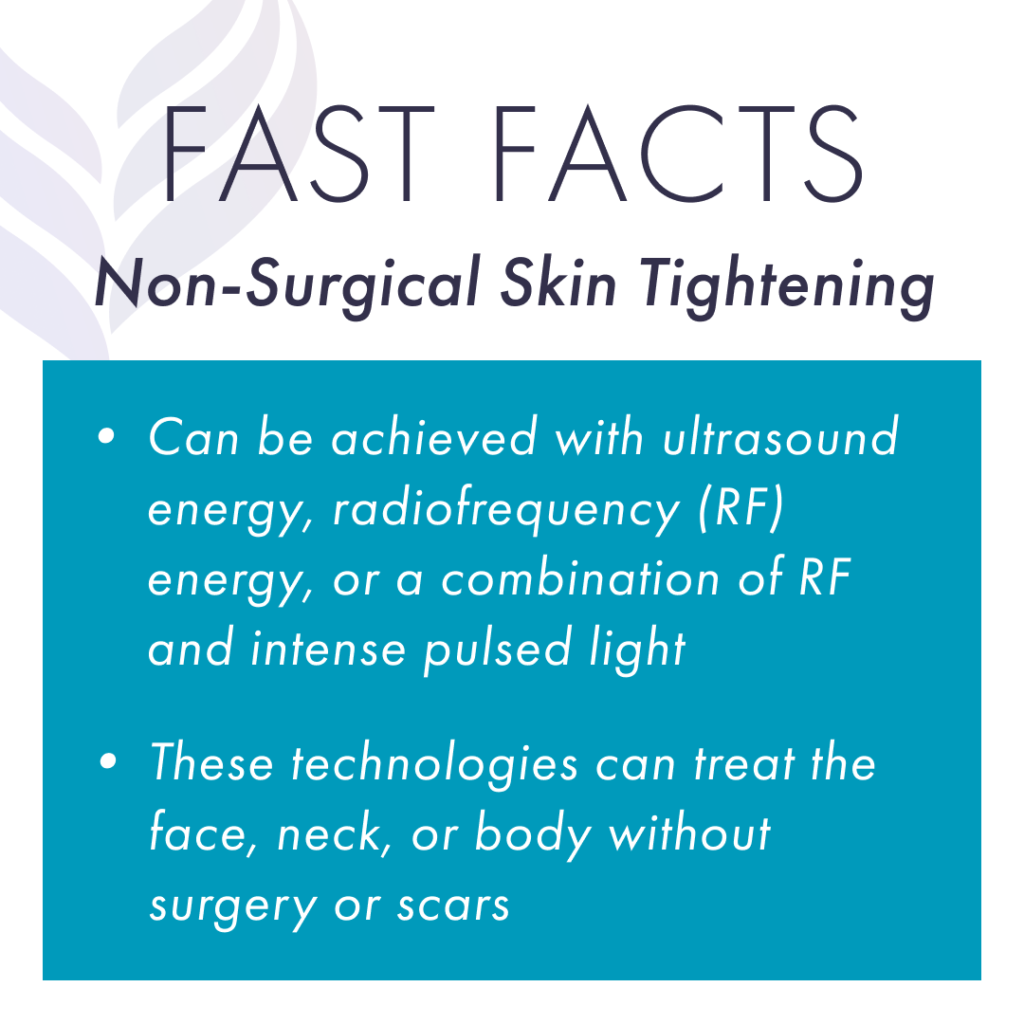
Why consider non-surgical skin tightening?
As we age, production of collagen and elastin—two proteins that help our skin stay plump, firm and smooth—slows down, resulting in areas of lax, sagging skin on the face, neck and body. If you are bothered by skin laxity, non-surgical skin tightening can temporarily halt this process and restore a firmer, smoother, more youthful appearance with little to no downtime.
Benefits of non-surgical skin tightening
- Tightens mild to moderately loose skin on the face, neck, or body without surgery or scars
- Many treatments can provide a noticeable “lifting” effect
- Little to no downtime is needed
- Very low risk of adverse effects when performed by a qualified provider
- Treatments can be performed in-office, typically in 1 hour or less
- Results can last up to 1 year
Limitations
- Results appear gradually over several weeks or months following treatment
- Multiple treatments may be needed to achieve desired results
- Treatment will need to be repeated periodically to maintain results
- Not effective on more advanced skin sagging, such as pronounced jowling or stretched skin following pregnancy or weight loss
- Key Benefits
- Glossary
- Firms the skin: Skin tightening procedures, such as Thermage and Ultherapy, can tighten loose or sagging skin on various areas of the body, such as the face, neck, and abdomen.
- Reduces wrinkles: In addition to creating firmer skin, skin tightening procedures can also reduce the appearance of wrinkles and fine lines, creating a smoother complexion and reversing signs of aging.
- Enhances skin tone: By stimulating collagen production, skin tightening procedures can also enhance skin tone and texture, creating a more radiant and healthy appearance.
- Collagen: A protein found in the skin that provides structural support and strength.
- Elastin: A protein that allows tissues in the body, including the skin, to resume their shape after stretching or contracting.
- Non-invasive: Referring to a procedure or treatment that does not require surgical incisions or penetration of the skin.
- Ultrasound waves: High-frequency sound waves used in medical imaging and therapies to visualize and/or target tissues beneath the skin.
- Radiofrequency energy (RF energy): Electromagnetic energy used in cosmetic treatments to deliver heat to the skin and stimulate collagen production.
- FDA cleared: Indicates that a moderate-risk medical device has been determined by the U.S. Food and Drug Administration to be safe and effective for its intended use based on substantial equivalence to a predicate device.
- FDA approved: Indicates that a high-risk medical product (i.e. a drug or implantable device) has undergone pre-market review and approval by the U.S. Food and Drug Administration for specific uses based on valid scientific evidence of safety and efficacy.
- Intense pulsed light (IPL): A technology that uses a broad spectrum of light wavelengths to target various skin concerns such as pigmentation issues or hair removal.
- Skin elasticity: The ability of the skin to stretch and return to its original shape, influenced by collagen, elastin, and other factors.
- Collagen stimulation: Techniques or treatments aimed at promoting the production of collagen in the skin to improve its firmness, elasticity, and overall appearance.
- Skin rejuvenation: The process of improving the appearance and health of the skin through various treatments or procedures, often involving collagen stimulation, skin tightening, and texture improvement.
Am I a good candidate for non-surgical skin tightening?
Non-surgical skin tightening is generally best suited for patients who are bothered by mild to moderate skin laxity and do not need the more dramatic lifting and skin removal possible with cosmetic surgery.
While there are very few serious side effects associated with non-surgical skin tightening, it may not be appropriate for patients who are pregnant, taking certain medications, or have certain medical conditions.
The best way to find out if non-surgical skin tightening is right for you is to consult with an experienced cosmetic surgeon. Start by finding surgeons in your area who are certified by the American Board of Cosmetic Surgery (ABCS). Diplomates of the ABCS have undergone extensive training in surgical and non-surgical cosmetic treatments, and can help you choose the best option for your needs and goals.
Non-surgical skin tightening treatments & technologies
Outlined below are the most common FDA cleared technologies available in the U.S.
Ultrasound skin tightening
Some skin tightening treatments use focused ultrasound energy, which heats skin at specific depths (up to 5mm deep) and locations to induce collagen production and help skin become firmer. Treatments are delivered via a handheld device, which transmits the ultrasound waves through the skin’s surface. Ultrasound technology has been used in medicine for many decades, and ultrasound skin tightening has an excellent safety profile. It is effective for older patients looking for a mini facelift without surgery and for younger patients who want to maintain their skin profile and prevent skin laxity as they age.
Fast facts about ultrasound skin tightening:
- Ultherapy®, the most widely used name brand, is FDA cleared to treat the brow, chin, neck, and chest
- Best for patients who want to treat early signs of aging on the face and neck
- Can help postpone need for facelift surgery
- Treatments take 30 to 90 minutes, with no downtime
- Patients may experience temporary discomfort while the ultrasound energy is being delivered
- Side effects are typically mild and include temporary redness, bruising, and numbness
- Results are seen within 2 to 3 months and can last up to a year with good at-home skincare
Radiofrequency (RF) treatments
Radiofrequency (RF) energy can also be used to heat the skin and trigger collagen production. In contrast to ultrasound, RF focuses on epidermal layers to achieve a firmer, smoother appearance. Brand name treatments include Profound® RF, Exilis®, Morpheus8®, Renuvion, and Thermage®. Like ultrasound treatments, RF treatments are effective for smoothing and tightening skin in older patients as well as postponing the need for a surgical lift in younger patients.
Fast facts about RF skin tightening:
- FDA cleared options can treat the face, neck, hands, and body
- Treatments can be performed in-office, typically involve little to no discomfort, and require no downtime
- Most RF-only treatments are safe for all skin types
- Some procedures, such as EmbraceRF®, are considered “subdermal” and require one very small incision using local anesthesia
- Results appear gradually and, thanks to RF’s ability to stimulate collagen production, improve in the months following treatment
- RF microneedling is a new technology that allows surgeons to combine the benefits of microneedling and RF to stimulate more collagen & elastin and treat deeper layers of skin
- A series of 2 to 6 treatments may be recommended for optimal results
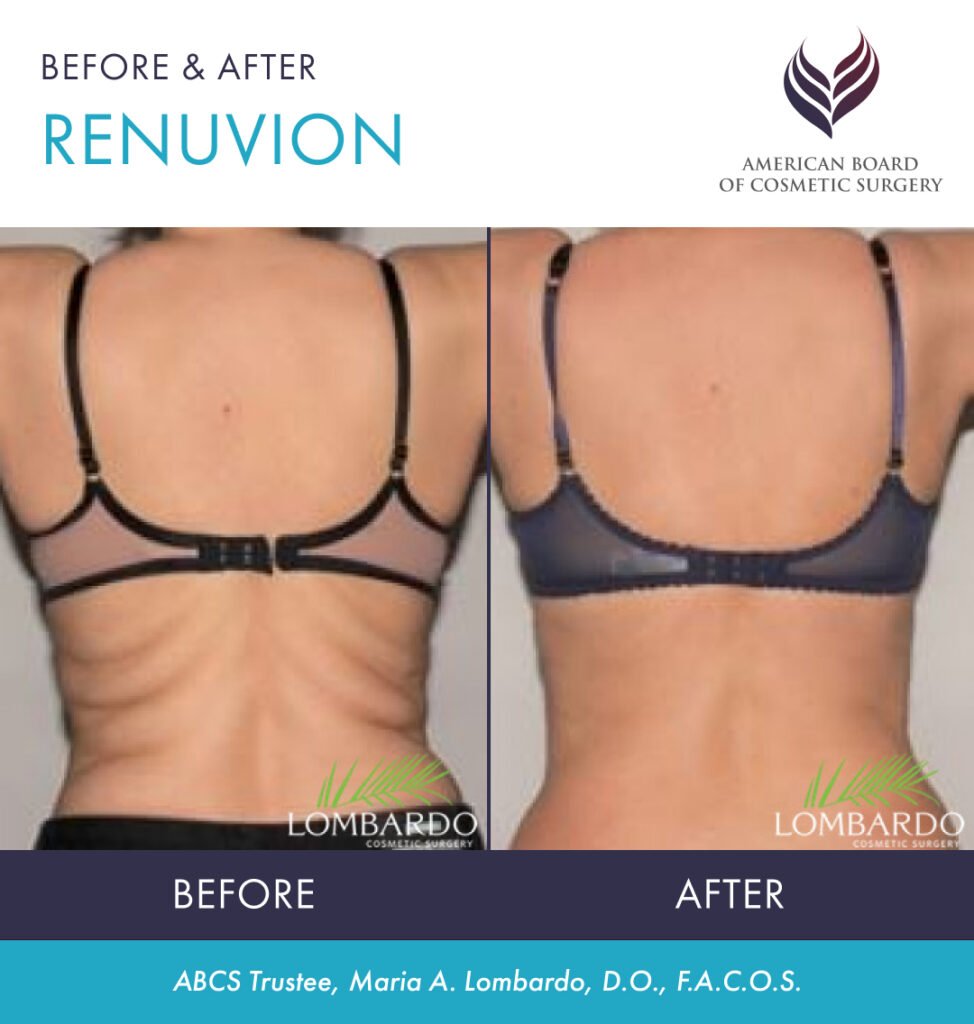
Combining IPL/RF treatments
A third class of skin tightening treatments combines intense pulsed light (IPL) with radiofrequency (RF) to heat deeper layers of skin and induce the natural healing response, which in turn triggers collagen production. The addition of IPL allows a provider to treat a large amount of skin and skin conditions, while the RF energy can be hyper-focused to treat deep layers of skin. Combination non-surgical skincare treatments tend to be extremely effective, as they are able to treat multiple concerns in one procedure. Commonly used treatments include Venus Versa®, and VelaShape®.
Fast facts about IPL/RF combination treatments:
- An IPL device sends out multiple wavelengths of light to treat a range of skin conditions simultaneously
- Treatments can be performed in-office with little to no downtime
- Patients typically experience little to no discomfort
- Results appear gradually as the skin produces new collagen
- A series of treatments may be recommended for optimal results
- IPL treatments may not be suitable for darker or tanned skin
Your Non-Surgical Body Contouring Options: An Infographic Guide
Non-surgical body contouring includes much more than skin tightening. Today, you have options to reduce fat, smooth cellulite, rejuvenate vaginal tissues, and remove unwanted hair. The guide below outlines all of your options.
Choosing a non-surgical skin tightening provider
In general, completely non-invasive skin tightening treatments can be safely performed by a licensed, trained aesthetician or registered nurse working under physician supervision. Subdermal treatments that require an incision, such as EmbraceRF, should be performed only by a qualified cosmetic surgeon or provider with equivalent training and experience.
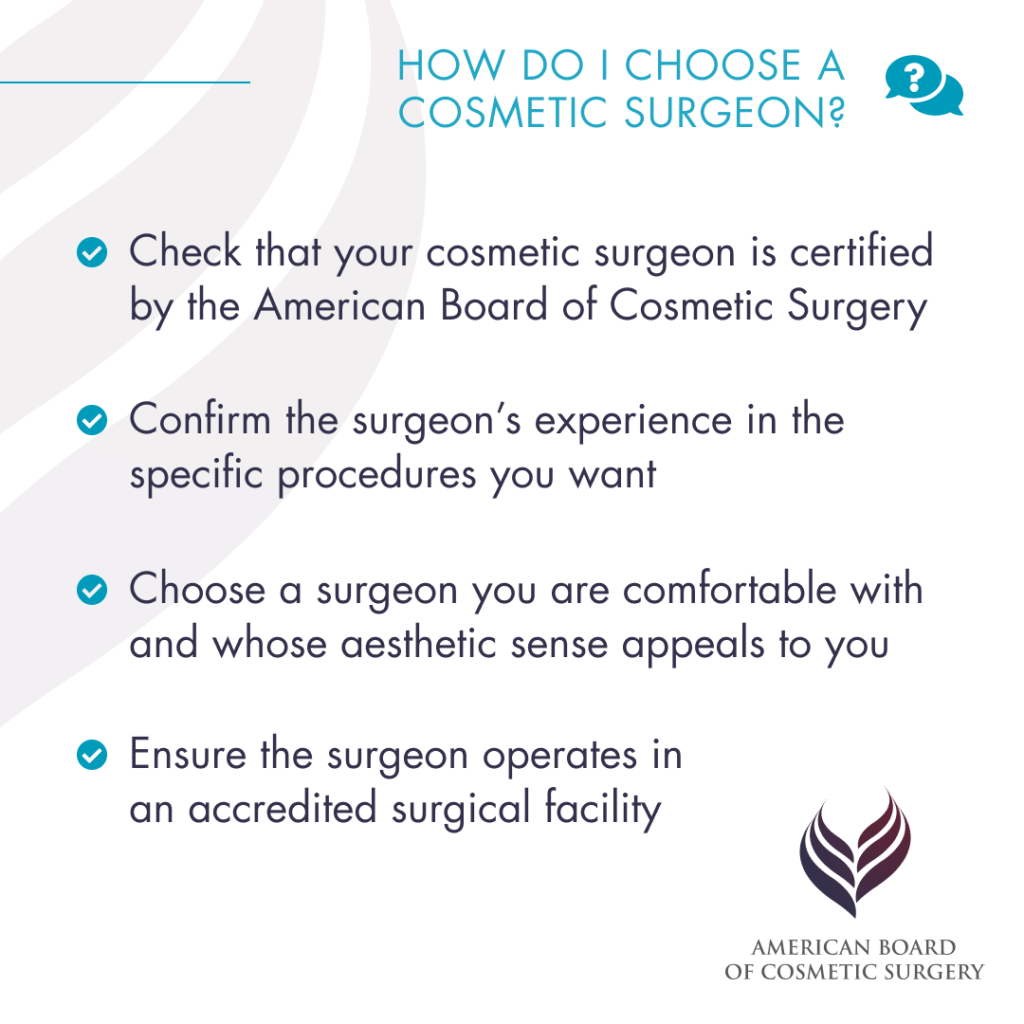
FIND AN ABCS COSMETIC SURGEON NEAR YOU »
The best place to start? Schedule a consultation with an experienced cosmetic surgeon near you to discuss your needs and goals, review your treatment options, and learn how non-surgical skin tightening can help you feel more confident in your appearance.
References »
Gold MH. Update on tissue tightening. Journal of Clinical Aesthetic Dermatology. 2010.
Hendricks AJ, Farhang SZ. Dermatologic facial applications of Morpheus8 fractional radiofrequency microneedling. Journal of Cosmetic Dermatology. 2022.
Kaplan H, Kaplan L. Combination of microneedle radiofrequency (RF), fractional RF skin resurfacing and multi-source non-ablative skin tightening for minimal-downtime, full-face skin rejuvenation. Journal of Cosmetic and Laser Therapy. 2016. doi: 10.1080/14764172.2016.1228981
Montes JR, Santos E. Patient Satisfaction Following Treatment With Microfocused Ultrasound With Visualization: Results of a Retrospective Cross-Sectional Survey. Journal of Drugs and Dermatology. 2019.
Rusciani A, Curinga G, Menichini G, Alfano C, Rusciani L. Nonsurgical tightening of skin laxity: a new radiofrequency approach. Journal of Drugs and Dermatology. 2007.
Weiner SF. Radiofrequency Microneedling: Overview of Technology, Advantages, Differences in Devices, Studies, and Indications. Facial Plastic Surgery Clinics of North America. 2019. doi: 10.1016/j.fsc.2019.03.002
